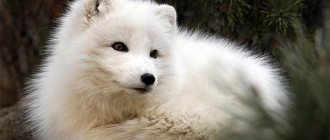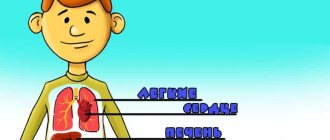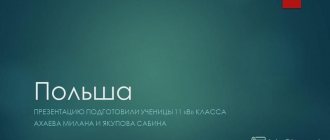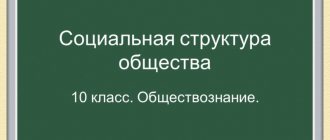How to paint the underwater world with paints. Master class with photos
Drawing with cotton swabs. Master class with photos
Master class on drawing “Underwater world”
Author: Tatyana Petrovna Dumler, art teacher at MAOU gymnasium No. 56 in Tomsk Purpose: this work is intended for little artists, teachers, and parents. Goal: Create a gouache drawing using an unconventional method. Objectives: - teach how to draw animals of the underwater world - develop imagination and creativity - promote the development of fine motor skills and attention. Materials: To complete this work we will need drawing paper, gouache, a brush, cotton swabs, a glass of water.
We invite first-graders to immerse themselves in the magical world of the sea kingdom. To begin with, a surface of water should appear on the landscape sheet. Using a wide brush, the children paint the background with cool-toned paints.
Gouache dries quickly. After a short conversation (or a game, riddles, presentation), the guys begin to draw sea creatures. We draw a turtle with brown paint: the body is a large oval, the legs are triangles, the head is a small oval.
Another amazing and beautiful inhabitant of the seas is the jellyfish. We paint it with lilac (or purple) paint. Semicircular body, ornate tentacles.
And of course, it’s hard to imagine the sea without fish, beautiful, unusual, fabulous. Using ocher (or yellow paint) we draw the body of an oval-shaped fish.
Cotton swabs have been used as a drawing material for a long time. But for young artists it is always very unusual and intriguing. I propose to decorate our heroes with patterns using cotton swabs.
We dip a cotton swab into the paint and apply it to the drawing, creating patterns. We continue to decorate the turtle. For each color we use a new stick and put them in a glass.
To decorate the jellyfish we use a pink palette. I suggest the guys mix white and pink paints to get a new shade. We also mix purple and white helmets. The guys apply patterns at their own discretion.
You can decorate fish with warm colors.
We paint the sandy bottom with yellow, brown, and ocher paints. First we paint the algae with a brush.
The children choose the further decoration of the drawing themselves. You can add other algae, you can draw rocks, shells, you can draw air bubbles.
Try this work with your students and you will see what wonderful “masterpieces” you will get. Good luck! Thank you for watching!
We recommend watching:
Drawing with palms in the middle and senior groups Fascinating drawing lessons in elementary school Master class on drawing for children Drawing lesson on the topic Summer for children of senior preschool age
Similar articles:
Drawing with cotton swabs in the preparatory group. Flowers
so UNT / Fine arts / Lesson plans for fine arts 2nd grade
Lesson 14 Topic: “UNDERWATER WORLD”. CONSTRUCTION AND REALITY
15.11.2013 18064 0
The theme of the collective composition is “Underwater World”.
The principle of organizing a collective composition:
sequential work from the background to the background.
Form of organization of collective activities:
combined - jointly-interacting and jointly-individual.
Type of occupation:
structural structure: three-dimensional image of figures of marine fauna and flora.
Goals and objectives:
acquaintance with the work of the artist-builder - Master of Construction; with the structural structure of objects and creatures of the surrounding world (created by nature or man), with the variety of structural forms in nature; give an idea of the connection between beauty and benefit, harmony and expediency of the design; mastering the expressive capabilities of artistic materials (paper, gouache); development of design skills; development of emotional, aesthetic, imaginative perception, creative abilities.
Lesson equipment: gouache, brushes, colored paper, scissors, glue, thread, needle, large sheet (A2-A1).
Visual range: slides and photographs of structural forms in nature (houses of mollusks, snails, caddis flies, turtles, honeycombs of bees, an egg, a poppy head or a pea pod and much more). Slides of architectural compositions.
During the classes
I. _
Class organization.
Checking absences and readiness for class.
II .
Conversation on the topic of the lesson.
Nature has created many buildings that look like houses. Some of them are very simple in form, others are complex and even intricate (see figure on p. 63).
For example, a box of poppy seeds. She is thin and fragile.
The pea pod consists of two elongated valves.
There are several rounded flaps in a cotton boll. When the cotton ripens, the shutters open.
The snail wears its own curled house, and the sea shells are also unusual in shape.
The shape of this shell prompted the Master of Construction to come up with a fairy-tale palace.
These are sea shells. Their shape is simple, but also very beautiful. One of them looks like a fan, the other shells look like magic cups.
The Master of Construction decided that a house that looked like a honeycomb could be beautiful and comfortable.
Let's take a trip to the sea. There we will see crabs and turtles, a lot of algae, umbrella jellyfish, fish with long tails that look like blankets.
The teacher generalizes and complements the students' knowledge about the inhabitants of the underwater world, paying special attention to the plastic forms of its inhabitants. Since students will have to depict the inhabitants of the sea using paper construction techniques, the teacher can compare natural forms with simple geometric shapes: cylinder, cone, triangle, circle, ball, prism, etc.
The teacher demonstrates techniques for working with paper and scissors, with which you can not only achieve maximum resemblance to the natural form of fauna, but also successfully convey the character of the inhabitants of the sea.
III .
Working on a task.
Collective composition. To create a collective volumetric-spatial composition, class students are divided into 2 groups: flora and fauna of the underwater world. Students of the first group (1/4 grade), doing the background for the general work, are divided into two small groups, as some depict water, the seabed directly on a large sheet, and others cut out silhouettes of algae from colored paper.
Schoolchildren of the second group are also divided into two groups - experts in fish, jellyfish, octopuses, crabs - and create three-dimensional images of the inhabitants of the underwater world using the paper plastic technique, using colored paper. (The work of these groups is carried out using technological cards.)
- Let's try to make sea inhabitants out of paper.
Stages of completing the task:
1) Let's start with algae. How to make a spiral algae?
— On a circle of white paper, draw a spiral line, similar to a curl;
- cut the paper along the line;
- take the cut paper by the middle. The algae will fall down like a spring.
2) How to make a seaweed tree or bush?
— Cut the paper into “noodles”;
- twist the stripes around the edge;
- roll the entire sheet into a tube and secure the edge with glue;
— so that the algae bush stands on a plane, cut the lower part in several places. Spread the resulting legs with glue and connect them to the plane.
3) Now let's make a fish.
— Fold a piece of paper stretched out lengthwise in half. The fold of the paper will be the fold of the back of the fish. Draw a curved line on this sheet below;
- cut out the shape of a fish along this line;
- cut the fish's tail and fins;
- Make herringbone cuts on the fold of the back and lift them up. Do they look like sharp fins?
4) We make jellyfish and turtles.
— Cut the paper circle to the middle;
— place the resulting parts on top of each other, forming a cone, and glue them together. This shape resembles the body of a jellyfish and turtle;
-make tentacles from thin sticks. To do this, the strips need to be twisted or folded like an accordion, and glued to the body of the jellyfish;
How to make a turtle - figure it out yourself.
5) Using ready-made blanks, we compose and assemble a collective spatial composition “Underwater World” (10 minutes before the end of the lesson).
Collective composition “Underwater World”. Paper
66
— Attach a background to the chalkboard;
— attach 2-3 cords horizontally to the doors of the chalkboard;
- use thin threads to hang silhouettes of algae, fish, figures of octopuses, crabs, jellyfish and other sea inhabitants on horizontal cords.
Note. If it is not possible to hang images of sea inhabitants on the board doors, then they are attached with glue to the background of the collective panel. You can make a “mobile” from three-dimensional figures of marine fauna, hang it on 3 thin slats, fastened in the form of a triangle.
Collective composition “Underwater World”. Paper
IV .
Lesson summary.
Analysis of common errors. Cleaning workplaces.
Homework:
observation of volumetric structures in life.
Art lesson for 2nd grade on the topic “Underwater World”
Development of a lesson in the 2nd grade by the fine arts teacher of MAOU “Cadet School No. 82” Khalide Rafgatovna Sadykova
Drawing on the theme “Underwater world” 2nd grade.
Target:
nurturing a love of nature, the ability to see and admire its beauty; learn to compose original compositions, continue to practice skills in working with a brush and wax crayons; promote the development of creative abilities, independence and accuracy, interest in fine arts.
Materials:
methodological picture plates depicting exotic fish and plants, slides and photographs of fish, inhabitants of the underwater world, a reproduction of A. Matisse’s painting “Red Fishes”, albums, watercolors, gouache, wax crayons, colored paper, brush, pencil.
Musical accompaniment - music “The Sound of the Surf”
1. Organizational moment.
Checking students' readiness.
2. Conversation on the topic of the lesson.
-Guys, what is your favorite time of year?
— How do you spend your summer? You go to a camp, to a village, to other cities, to the sea.
— Raise your hands, who was at sea during these holidays? (Children talk about their impressions)
- Let's dream today in class - imagine that you are on the shore of a warm sea or ocean, that you are walking along the sand, approaching the water - putting on fins and a mask and gradually plunging into the gentle, warm water. And suddenly, a magical and fairy-tale world opens up before us!
- Tell me, what did you see under water?
We saw the sea or ocean floor, on which strange plants grow that are not similar to those plants that grow on the surface of the earth. It was as if we found ourselves on another planet!
We saw many colorful shells and pebbles that cover the bottom, but most importantly, we saw underwater inhabitants - fish and other creatures living under water. Everything here is unusual, bright, colorful, magical, colorful!
— Guys, have you guessed what the topic is for our lesson today? Underwater world, underwater kingdom.
- And in which seas do the brightest, most beautiful inhabitants live?
Of course, the most unique, richest in diversity of inhabitants forms the community of coral reefs in warm seas.
- Does anyone know what kind of creatures these are - corals?
Corals are shells that are built by very small creatures, small sea animals called polyps. (Tiny jelly-like with many small tentacles).
They have neither head nor legs. They extract calcium dissolved in the water and use it to build their small houses. Living polyps—corals—develop on the skeletons of dead, obsolete corals. As a result, multi-ton reefs or atolls are formed, most of which are found in the Pacific Ocean (the islands of Bermuda or the Bahamas).
When there are too many polyps, they form large rocky formations - reefs. Colonies of corals can be found in all seas, but the corals from which reefs are created live only in clean, warm, shallow waters with a depth of no more than forty-five meters.
The reefs resemble luxurious, fairy-tale gardens, inhabited by many bizarre inhabitants. This community is one of the unique sea wonders (slide show, comments and description of the seabed, algae, fish).
3. Statement of an artistic task.
- Look how unusual and bright the fish are. Why do you think all the fish have such variegated colors? (To make it easier to hide from enemies among the colorful corals).
- What are these fish called? (Clown fish, surgeon fish, butterfly fish, dog fish).
- Do you think that if there are fish with such fancy names (dog fish, butterfly fish), there could be a cat fish, a spider fish, a teacher fish?
- So, we can draw not only what we saw, but also come up with different underwater inhabitants ourselves?
— Besides fish, what other inhabitants of the underwater world are there? (Jellyfish, stars, crabs, oysters, mussels, etc.)
— What are the names of plants that grow on the seabed? ( Seaweed).
—What is the seabed covered with? (Sand, stones, shells...)
—What do corals look like? (Like intricate plants, branched and colorful). (Showing reproductions of A. Matisse’s painting “Red Fishes”, slides, photographs and postcards).
So, your task today is to create a composition depicting the underwater world, with unusual fish, unusual creatures, unusual plants. (Display various composition options on the board). Use different materials, paints, crayons, markers.
4. Independent work.
Individual work between the teacher and the class. The music “Sound of the Surf” plays.
5. Analysis of exhibited drawings, evaluations.






